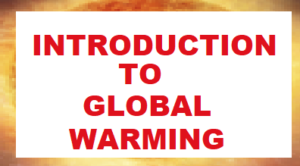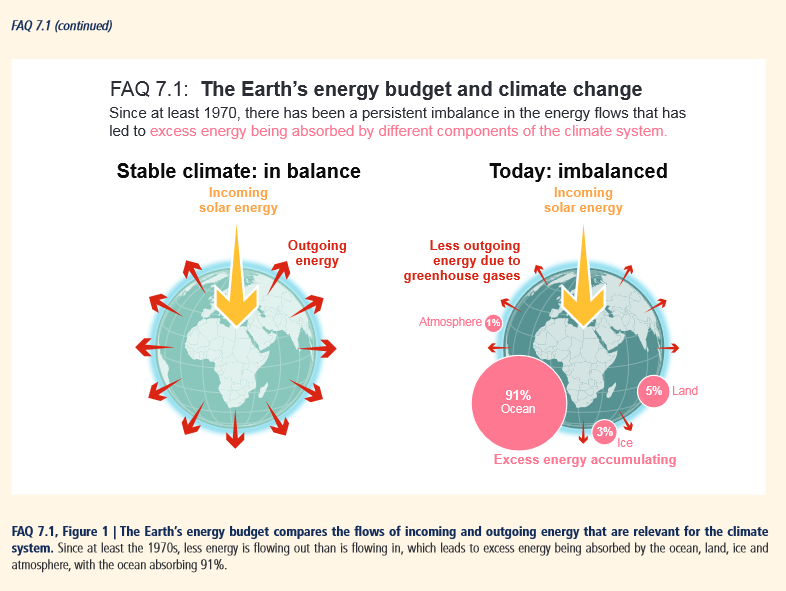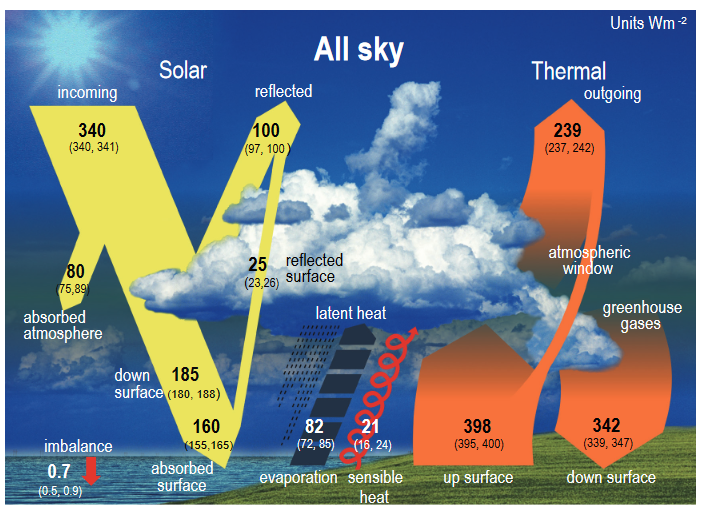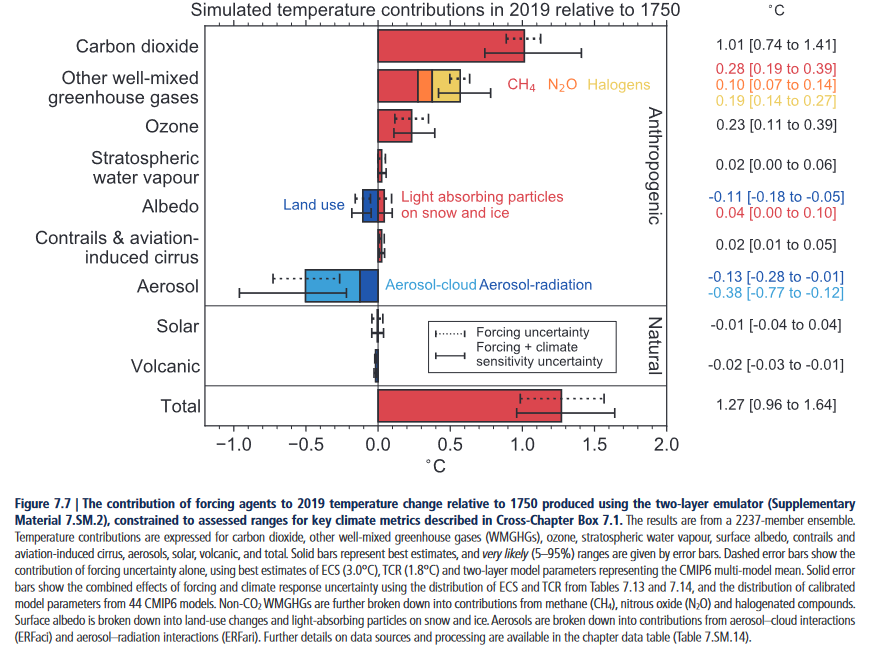It is time to talk about Global Warming. I prefer the term Global Warming(GW) to Climate Change(CC) simply because it is the warming that changes the climate. But either term is fine. We are going to tackle this in small portions. It is a very complicated and a largely misunderstood topic. My major interest is the economic impacts but I think we need to start by understanding what Global Warming is and why it is happening.
In Part I, I am going to discuss the imbalance between incoming energy and outgoing energy. I am also going to try to explain why it is happening and the role of greenhouse gases. I believe we are at the point now where there is no doubt that this is caused almost totally by the activities of humans. But even if it was a natural phenomenon, what I am presenting in this article would apply. The only way to get warmer is to receive more energy than you send into space. Not being in balance could be caused by humans or by something else. We will deal with the cause in a future article. Part I of this Introduction to Global Warming is about the imbalance.

| Let’s get started. |

| This graphic describes the difference between a stable climate (to some extent, I would prefer that it said warmer climate but warmer then affects precipitation and wind, etc so it is correct) and a situation that is not in balance. All these graphics except one are from the AR6 IPCC Working Group I Report. I played a very minor role in the preparation of this report as an Expert Reviewer. “The Intergovernmental Panel on Climate Change (IPCC) is the United Nations body for assessing the science related to climate change.
They are not the only organization that focuses on this topic. But they are probably recognized as the entity that does the most work in this area. They redo their assessment every seven years with this set of reports called AR6 because it is the sixth assessment report. HERE is a link to the website which describes the work of the IPCC and the Sixth Assessment Report. Of interest in the above graphic is the estimate that 91% of the excess energy has been going into the oceans. I am a bit surprised by that large a percentage but it makes sense when I think about it a bit. I believe oceans cover more than 70% of the surface of the Earth and land is better at reflecting energy so I can see the reasonableness of that estimate and it has a lot of implications. We will get into it in a future article but it means that, unlike the rumors, precipitation will increase. I have to qualify that somewhat as GW also impacts the way clouds are formed and function. As you see, things get complicated quickly. Warmer means more evaporation so it means there will be more moisture entering the atmosphere. The capacity of a warmer atmosphere to hold moisture also increases but a larger quantity of moisture entering the atmosphere results in increased precipitation. But it also means that this precipitation will evaporate faster and return to the atmosphere. Where it precipitates may change. We see this playing out already but that is for a later article. I only mentioned it because I was surprised by the 91%. Maybe we will talk about ocean ecology in a future article. |

| This is the key. This version is from the IPCC report. The source is Wild et al., 2015. There are other versions. They measure the energy at the Top of the Atmosphere (TOA) since incoming will be impacted by the atmosphere and the surface of Earth and outgoing will not be further impacted. The units are watts per square meter of the Earth’s surface: 340 incoming. about 339 outgoing. So the difference is small. Here it is estimated as 0.7 with a confidence interval of 0.5 to 0.9. It is small but it is cumulative. So that is the problem. It is a busy graphic. You can see the amount of energy that is reflected by clouds (and aerosol). The big number is the energy emitted by Planet Earth – radiated energy increases by a factor of 16 (2 to the 4th power) when the temperature – measured in degrees Kelvin doubles. A lot of it escapes in Space but a lot does not and is bounced back by what is called greenhouse gases. How reliable is this analysis? In theory 0.5W to 0.9W is about 95% likely. I am not sure I believe it. I have seen different estimates but it may be that they were earlier. What we know for sure is the oceans are warming. So I think we know that there is an imbalance. You can read Chapter 7 of the AR5 WGI Report and draw your own conclusion. Since I am a mathematician, I have to be a bit skeptical even though I only took one course in numerical methods. The error terms are nasty little creatures. The IPCC recognizes the difficulty of getting the Energy Budget pinned down. The discussion in Chapter 7 of IPCC AR6 WGI is very interesting. Here is the link. The energy budget is really the key issue in climate science. We will discuss that in more depth in a future article |

| Source: Wikipedia – I do not know where to begin. I used to have a simpler graphic but where is it? Starting at the top is the key factor that incoming from the sun is shorter wavelength (higher frequency) than energy origination from Earth. This is very important. Then it becomes a question of what substances absorb, reflect, or allow different energy with different wavelengths. This results in certain windows where energy can pass through. Greenhouse gases and certain particles interfere with energy being able to pass through. As we change the composition of the atmosphere we change how this works. One also has to consider interactions. As you can see carbon dioxide has less of an effect than water vapor. But carbon dioxide blocks some wavelengths that water vapor does not. This results in some warming. The warming results in more evaporation from oceans so you have more of the more powerful greenhouse gas in the atmosphere. So that addresses the question of why worry about carbon dioxide when water vapor is a much more powerful greenhouse gas. |
–

| This graphic which is based on simulation studies is trying to show how we got to the increase in temperature that we have experienced. It only considers the human impacts. The full analysis considers the other impacts which are considered to be small. Volcanoes have a big impact but it only lasts a small number of years. I only see water vapor here in the stratosphere which confused me at first. For sure more moisture results in more warming (see NASA article HERE). But humans are not adding moisture to the atmosphere so it is not shown as a separate human-caused “forcing”. Stratospheric water vapor is shown due I think to oxidation of methane but I am not sure why it is broken out separately. Of most interest is the negative impact of what is called aerosols. Initially, the focus was on sulfates. But the analysis has been expanded. Here is where I chime in with reducing pollution has increased warming as it has reduced the impact of aerosols to increase albedo. So one strategy for dealing with Global Warming is to put more particles in the atmosphere to increase albedo and this is sometimes referred to as “cloaking” but it is not polite to even mention this mitigation strategy. In ten years it may be considered if other approaches are not as effective as we hope they will be. |
HERE is the link to Chapter 7 of the Working Group I Report. The approved abbreviation for Climate Change is “Clim. Change”. I use CC which I think is acceptable. I am not aware of an approved abbreviation for Global Warming. I use GW in my writing.

| I hope you found this article interesting and useful. Questions and comments are appreciated. |
The Sellers Book I gave you deals in a more quantitative way than the IPPC report for its time (1967) it seems. But Sellers did not get into the affect of climate change factors on the overall energy budget. What is neglected in everyone’s causes is the generation of methane gas on the ocean floor and the generation of methane gas by serpentinization of ultrabasic rock in subduction zones. In addition the X???lub. meteor the end of the Cretaceous is characterized by existence of subduction nearly everywhere where the process takes place.
Bill,
We know that serpentinization releases H2 and from H2 methane can be generated. Finding the estimate of that in the IPCC report is challenging. They do have estimates of methane produced by rock weathering and from ocean sediments. Someone named Levy seems to be important in this field and I did not find him listed as an author in WGI Chapter 5 but he is mentioned as a source of data. It is my understanding that the life forms at these seeps consume most but not all of the methane. I find it very difficult to track down questions like this but for the U.S. there is a report on sources and sinks for greenhouse gases (GHG) so I assume that something like that exists for IPCC AR6. Perhaps it is in what they call the Atlas. What is important is that this sort of natural source is not likely to vary by year, unlike human-caused (anthropogenic) sources. It gets complicated when warmer temperatures change the rate of release of GHG.
In general, all estimates in the IPCC reports can be challenged and are challenged. Each new edition, every seven years, is different and hopefully better. The IPCC does not seem to have a problem admitting that a prior edition was wrong.
In Part II of my Introduction to Global Warming, I will be addressing the way forecasts are produced which deals with the issue of temperature sensitivity to changes in carbon dioxide and its equivalents in the atmosphere. The main sensitivity measure used is called the TCR or Transient Climate Response and there are ongoing controversies about the estimates even though the confidence intervals are quite large. So calibrating the forecasting models is a major area of activity.
My major interest is the economic impacts but I felt that one needs to start with the scientific basis for making the estimates of how temperature and other aspects of climate might change over time. The IPCC deals with the uncertainty by using a scenario approach and this is a useful approach for dealing with uncertainty but leads to many problems as the media (and also those doing studies) tend to focus on the most dire forecasts. This forecast is called Business as Usual (BAU) and most agree that it will not be that bad but some think it might be worse. So there are plenty of obstacles to figuring out the best way to deal with Global Warming.
I am disappointed that the IPCC in WGI seems to be debunking certain approaches e.g. removal and sequestration. I would think that belonged in WGIII. I think it was a major mistake to address it in WGI.
Sig
Thx Sig. Well done article. One aspect I’ve only seen from my college days, was the input of heat from combustion and heat losses of all the machines and heating we do. Cars, trucks, heating, manufacturing, transportation etc. it’s not an insignificant number but I can’t find any specifics to give you.
I also agree that what I’ve head the term used is geo engineering vs cloaking will probably be used to try and reduce the temperatures.
Jay
Hi Jay, The National Academies of Sciences, Engineering and Medicine wrote a report actually two on ways to deal with Global Warming in 2015 and I wrote an article on that https://econintersect.com/b2evolution/blog1.php/2015/08/03/new-approach-to-dealing-with-climate-change. I checked and the links to those reports which are in my article still work.
The White House was not happy that this happened. A couple of years ago The National Academies did a study to determine if they should look at increasing the ability to reflect sunlight. I did not keep track of their conclusion and I do not know if they went forward or not.
One problem with cloaking is that it keeps things cool but does not reduce GHG. Basically, it increases the reflection of sunlight which also reduces brightness which many would not like. It also to some extent reduces the effectiveness of solar worldwide. A major issue is how would other nations feel about it. So from a practical perspective, you can only do it if everyone important agrees and perhaps only if everyone agrees which never happens. So technical reasons are not the major constraint with respect to doing this or even talking about it.
It is there if needed and letting people know it is there increases the chances that it will be needed so the idea is to keep it quiet that we have a fallback plan. But my job as a journalist is to provide information not keep people in the dark.
You are correct about the heat losses but it is a double whammy since losses generally mean you need to replace those losses with more energy which often means releasing more GHG. There is a lot that can be done to improve the situation and in many cases, it is being done. Fortunately, we have a favorable situation where essentially everyone wants to reduce their cost of energy. So it does not require anything other than providing the means to reduce energy consumption at a cost that is less than the price of the energy that is being replaced.
I do not have a plan for the articles I am going to write on Global Warming/Climate Change I think I know what is going to be in the next article but beyond that, I have to think about it. So I appreciate all input. Feel free to send my article to anyone who might find it interesting.
Sig